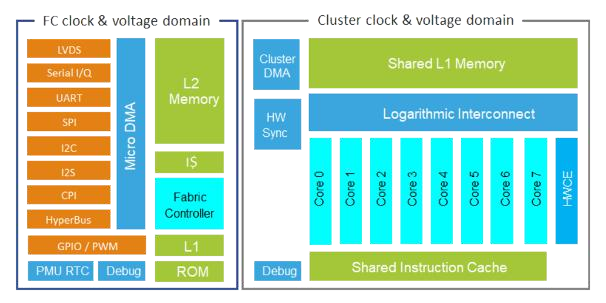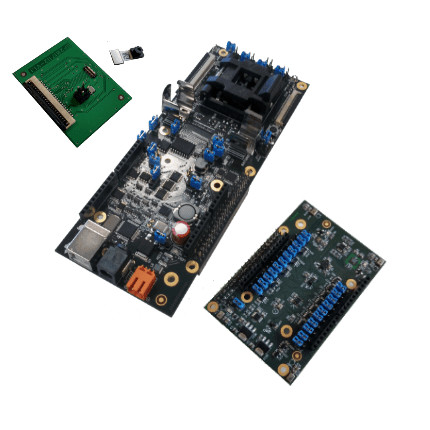GreenWaves Technologies, a fabless semiconductor startup based in Grenoble, France, has designed GAP8 IoT application processor based on RISC-V architecture, and optimized for image and audio algorithms including convolutional neural network (CNN) inference with high energy efficiency thanks to an 8-core computational cluster combined with a convolution hardware accelerator. The design is based on RISC-V based Parallel Ultra Low Power (PULP) computing open-source platform.
The new processor targets industrial and consumer products integrating artificial intelligence, and advanced classification such as image recognition, counting people and objects, machine health monitoring, home security, speech recognition, consumer robotics, wearables and smart toys.
 Some of GAP8 processor specifications:
Some of GAP8 processor specifications:
- 1x extended RISC-V fabric controller core with 16 kB data and 4 kB instruction cache for system control
- 8x extended RISC-V compute cores with 64 kB shared data memory and 16 kB shared instruction cache
- 1x Hardware optimized synchronization unit
- 1x Hardware Convolution Engine (HWCE)
- Multi channel 1D/2D DMA, specialized multi-channel micro DMA for autonomous peripheral support
- Programmable Voltage Regulator
- Real Time Clock
- 2x programmable clocks
- Secured execution support with Memory Protection Unit
- 512 kB State Retentive L2 Memory
- Optional external high speed low power SDRAM up to 16 MB, through HyperBus
- 32 kHz external quartz, Up to 250 MHz internal clock
- I/O interfaces
- 128 Mb/s LVDS IEEE compliant
- Serial I/Q
- UART
- Quad SPI Master + additional SPI Master, SPI Slave
- 1x I2S
- 1x I2C
- 1x Camera parallel interface
- HyperBus (External Flash and RAM)
- Up to 32 GPIOs
- 4x PWM
- Supply Voltage
- 1.2 V down to 1V core VDD supply
- 1.8 V to 3.3 V for I/Os
- aQFN 84 package
The processor is capable of delivering up to 8 GOPS at a few tens of mW, or up to 200 MOPS at 1 mW thanks to partially a cycle 5×5 convolution. The company compared the (theoretical) performance differences between GP8 to STM32H7 (Cortex M7) MCU for a CNN graph, and we can clearly see the massive advantage the new processor has for that particular task.
| Target | Clock | Time | Cycles | Active Power |
|---|---|---|---|---|
| STM32H7 | 216 MHz | 99.1 ms | 21 405 600 | 60 mW (STM32H7) |
| GAP8 | 15.4 Mhz | 99.1 ms | 1 527 232 | 3.7 mW |
| GAP8 | 175 Mhz | 8.7 ms | 1 527 232 | 70 mW |
If GAP8 is configured to run at 15.4 MHz it can complete the task as fast as STM32 F7, but using only a fraction of the power, or run the task over 10 times faster when clocked at 175 MHz with a only slightly higher active power. Another way to look at power consumption, is the company’s claim that the processor can classify a QVGA image every three minutes for 10 years on a small 3.6 Wh battery.
Some typical use cases include:
- Always-on face detection with a few mWs of power
- Indoor people counting / presence detection with years of autonomy
- Sub $15 machine vision and voice control solutions for consumer robotics
- Single-chip processing for 4 microphone voice capture and 10-word speaker-independent keyword spotting
 The company also offers a development kit comprised of GAPDUINO board, a sensor board, and a QVGA camera module. Besides GAP8 IoT processor, the Arduino compatible board features the following:
The company also offers a development kit comprised of GAPDUINO board, a sensor board, and a QVGA camera module. Besides GAP8 IoT processor, the Arduino compatible board features the following:
- Memory / Storage – 256Mbits SPI flash, I2C EEPROM, HyperBus combo DRAM/Flash 512Mbits Flash + 64Mbits DRAM
- Camera connector for an external camera (e.g. Himax HM01B0)
- USB port
- USB to GAP8 JTAG + UART
- Misc – Reset button, Configurable I/O voltage
- Battery holder (SAF17500), DC connector
- Arduino Uno compatible Master/Shield
GAP8 can be programmed like any MCU thanks to GAP8 SDK including:
- The RISC-V GCC/GDB toolchain with extensions to the optimizer for the extra instructions that we have added to GAP8
- The MCU/Fabric Controller side tools include 2 OS choices (this list will be extended in the future): PULP OS, or Arm Mbed OS (for RISC-V/GAP8)
- Cluster side development tools – GAP8 AutoTiler to generate C code to automate the movement of data between L2 or external memory.
- Code generators for the cluster – GAP8 Generator Library including different algorithms developed using the GAP8 AutoTiler. It includes CNN layers, FFT, Matrix Operations, FIR Filters, and more.
You can find more details about the GAP8 processor, and/or pre-order the development kit (199 Euros) scheduled to ship in April 2018 on the GreenWaves website. The company is also attending Embedded World in Germany at the RISC-V Foundation booth (Hall 3A, Booth 3A-419).
Thanks to TLS for the tip.

Jean-Luc started CNX Software in 2010 as a part-time endeavor, before quitting his job as a software engineering manager, and starting to write daily news, and reviews full time later in 2011.
Support CNX Software! Donate via cryptocurrencies, become a Patron on Patreon, or purchase goods on Amazon or Aliexpress




